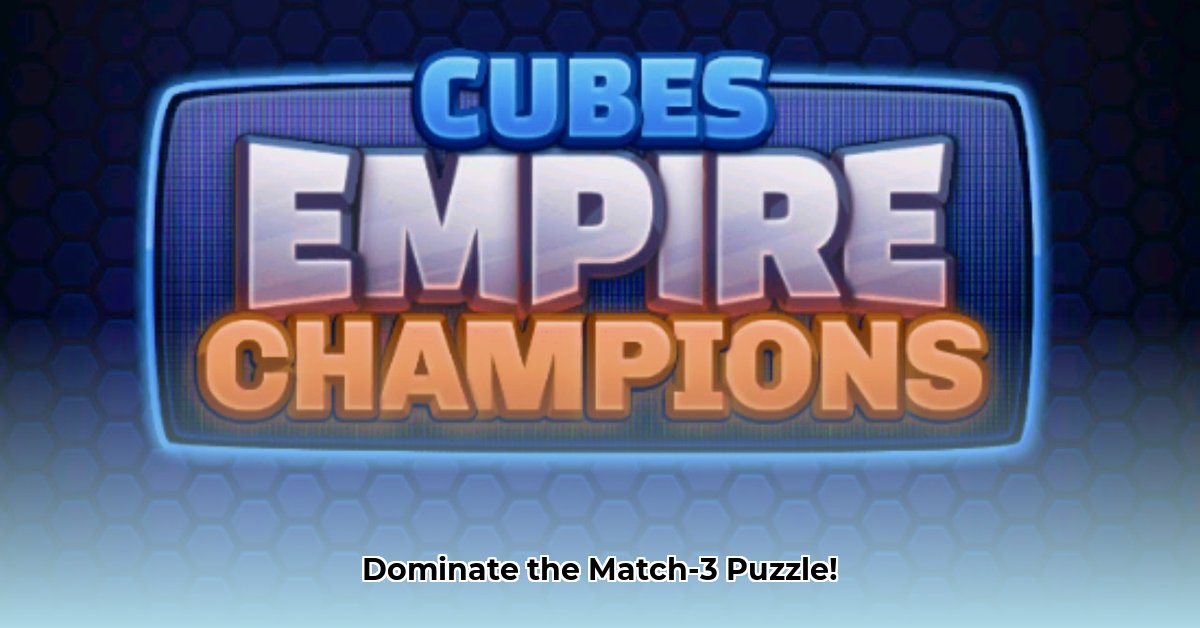
Cubes Empire Champion: Can This Match-3 Game Rule the Puzzle Realm?
Cubes Empire Champion (CEC) enters a fiercely competitive mobile gaming market. Its match-3 gameplay—swapping colored cubes to create chain reactions—is familiar, but success hinges on differentiation. Can CEC carve a niche for itself and truly become a champion? This analysis explores the game's potential, challenges, and strategic recommendations for its long-term viability.
The Match-3 Battlefield: A Crowded Arena
The match-3 genre is saturated. Thousands of apps compete for players' attention. CEC boasts hundreds of levels and polished visuals, suggesting high user engagement potential. However, simply offering abundant content isn't a guarantee of success. What truly matters is unique gameplay mechanics or a compelling twist that distinguishes CEC from its competitors. Without innovation, CEC risks becoming another quickly-forgotten entry in a crowded field. How can CEC stand apart? This is a key question the developers must address.
Making Money in the Match-3 World: The Fine Art of In-App Purchases
CEC relies on in-app purchases (IAPs) for revenue. The success of this strategy depends entirely on the delicate balance between offering tempting purchases and avoiding alienating players. Will "awesome prizes" translate into consistent revenue, or will an aggressive IAP strategy drive players away? A subtle yet effective monetization strategy is crucial for long-term sustainability.
Strategies for Long-Term Success: From Short-Term Wins to Sustainable Growth
CEC's survival depends on a strategic roadmap. In the short term, player data analysis is critical. Identifying levels that prove too difficult, determining popular power-ups, and understanding player purchasing behaviors are all vital steps. This data directly informs game adjustments, power-up enhancements, and more enticing IAPs. A data-driven approach is essential for fine-tuning the player experience and maximizing revenue.
Long-term success requires innovative game modes and sustained player engagement. Consider introducing competitive elements like leaderboards or tournaments, or even exploring cooperative gameplay. Expanding to new platforms, such as desktop browsers, could also broaden the player base. How can CEC continue to engage players and grow its revenue stream? Diversification is key.
Potential Pitfalls and How to Navigate Them: Risk Assessment
CEC faces significant challenges. Here's a risk assessment matrix outlining potential pitfalls and their mitigation strategies:
| Risk Factor | Likelihood | Impact | Mitigation Strategy |
|---|---|---|---|
| Difficulty Attracting Players | Medium to High | High | Aggressive marketing, strategic social media engagement, ASO optimization. |
| Player Churn | High | High | Exciting new content updates, frequent events, and community building. |
| Intense Competition | High | Medium | Unique selling proposition (USP); focus on a distinct element. |
| Unbalanced Monetization | Medium | Medium | Continuous A/B testing of IAPs, ensuring a fair and enjoyable experience. |
The Verdict: A Champion in the Making?
CEC has potential, but its success hinges on several factors. A balance between enjoyable gameplay, fair monetization, and consistent content updates is paramount. The developers' skill in adapting to player feedback and creatively refining the game's strategy will ultimately determine CEC's long-term prospects. Only time will reveal if it can overcome fierce competition and establish its place in the match-3 arena.
How to Improve Cubes Empire Champions' In-App Purchases
Understanding the Puzzle: Gameplay Mechanics and Monetization
CEC's success depends on thoughtfully integrating its playful match-3 gameplay with a sustainable monetization strategy. Its core mechanics are engaging, but translating that engagement into revenue requires careful planning. Power-ups enhance the gameplay experience, but their strategic integration into IAPs is crucial.
Strategic Recommendations for Developers
The key for CEC developers is a two-pronged approach: enhance the core experience while implementing a compelling and non-intrusive IAP strategy.
Short-Term Strategies:
- Analyze Player Data: Track and analyze player behavior to pinpoint areas of frustration. This informs game adjustments and IAP optimization for better player engagement.
- Optimize Power-Up Effectiveness: Ensure power-ups are powerful but not game-breaking. This increases their appeal and incentivizes purchasing.
Long-Term Strategies:
- Implement a Robust Monetization Strategy: Design a fair and balanced IAP system. This could include carefully placed non-intrusive ads, a battle pass, or cosmetic items, avoiding exploitative practices.
- Expansion Packs or Sequels: Long-term success may require sequels or expansion packs to maintain engagement and generate revenue streams beyond the initial release.
The Player's Perspective: Mastering the Game
Players can also optimize their experience.
Short-Term Tactics:
- Master Core Mechanics: Practice improves cube-matching skills and enhances scores.
- Utilize Power-Ups Effectively: Strategic use of power-ups is crucial for overcoming challenges.
Long-Term Goals:
- Explore Advanced Strategies: Discover advanced techniques through online communities and discussions to refine gameplay.
- Community Engagement: Join online communities for helpful tips and to enhance the social aspect of the game.
Risk Assessment: Navigating the Challenges
| Risk | Likelihood | Impact | Mitigation Strategy |
|---|---|---|---|
| Poor IAP Design | Medium | High | Thorough user testing; iterative design improvements. |
| Negative Player Reviews | Low | Medium | Proactive community management; address player feedback promptly. |
| Lack of Long-Term Engagement | High | High | Regular content updates; expansion packs; community events. |
⭐⭐⭐⭐☆ (4.8)
Download via Link 1
Download via Link 2
Last updated: Monday, May 12, 2025